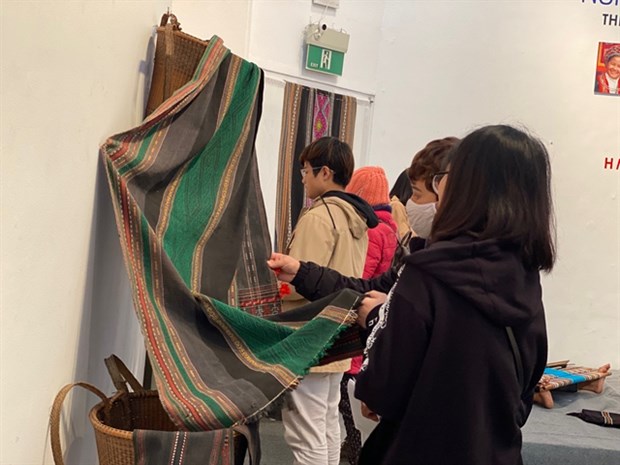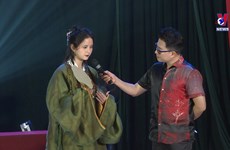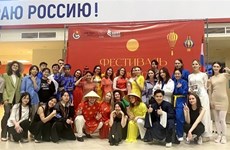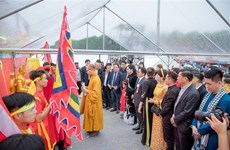Traditional weaving exhibition draws Hanoi audience
Hundreds of people interested in the traditional handloom weaving skills of ethnic minorities in Vietnam flocked to an exhibition at the Goethe Institute in downtown Hanoi over the weekend to see products and demonstrations by artisans.
 Illustrative image (Photo: VNA)
Illustrative image (Photo: VNA) The Art of Indigenous Weaving, an event hosted by Craft Link, introduced the skills of the ethnic Mong in the northern province of Ha Giang, the Thai ethnics from the central province of Nghe An and the Chau Ma from the Central Highlands province of Lam Dong.
Tran Tuyet Lan, general director of Craft Link Society Enterprise, said the special feature in this event is that six representatives of the three ethnic groups from the three regions of the country were invited to demonstrate their handloom weaving skills at the site.
“The three groups have three ways of weaving traditional cloth,” she told Viet Nam News. “You can see here their similarities in culture as well as their differences in weaving culture.”
Lan explained that during the 26 years of running the enterprise, Craft Link has worked with various ethnic groups throughout Vietnam, many of them having special traditional weaving skills handed down through generations.
“During the development process of modern society, many ethnic groups have seen their weaving skills face away, which is regretful,” she said. “Factories produce new kinds of cloth quickly at cheap prices. It’s very difficult for such traditional weaving products by remote ethnic groups to compete against industrial textiles.”
That’s why Craft Link hosted this exhibition to introduce these valuable skills by ethnic groups, she said.
“We want to send a message that we should preserve the traditional identity of ethnic groups through their traditional handicrafts and help them bring the handicrafts to international friends,” she said. “They can create beautiful products for various markets in the world," she said.
Lan said their products have been highly appreciated in foreign markets.
“When working with the ethnic groups, we have done research to understand their cultures and the way they use the cloth in daily life to design the product for a better function and more suitable to the international market,” she said.
Sung Thi Van Anh of the Mông ethnic group in Quan Ba district, Ha Giang province, demonstrated her skills at the exhibition.
“I’m weaving a linen cloth from flax,” she said. “It takes us a lot of time to make a cloth from tearing off fibres, discolour the fibres, and several steps before reaching this weaving step,” she said.
Anh said she learnt weaving techniques when she was small from her grandmother and mother.
“I liked weaving and tried to learn the skills,” she said. “Though there are many more durable, beautiful kinds of cloth in the market, I think our traditional linen cloth cannot be replaced. We still wear it for festive occasions. It’s natural and has been associated with my ethnic group for a very long time,” she said.
Anh said women of her age still maintain weaving skills.
“I feel proud of this weaving skill and would like to introduce it to international people,” she said.
Dieu Thi Moc of the Chau Ma ethnic group from Lam Dong said she gets a stable income from weaving traditional cloth.
Moc said with her handloom weaving skills, she uses her hands even though now there are machines that do this job.
“We still prefer the artisanal cloth as the patterns are much sharper and dyed colours look more beautiful,” she said.
Along with 6 million VND (246 USD) in monthly income from weaving, Moc also earns money from cultivating cashew and rice.
“We will never stop this traditional weaving as we still can live on it,” she said.
Cindy Cutler, a US citizen based in Hanoi for three years, spent a long time at the event.
“This is a wonderful exhibition,” she said. “I’m very impressed with the educational aspects and they explain the techniques and how much goes into making these beautiful products. I have just been in Ha Giang and I saw women wearing traditional dress and still doing traditional trades,” she said.
Cutler appreciated the diversity of the different products and that the event was translated into English at the Goethe Institute.
“It’s a very educational exhibition with the artisans here so you can see them making the products,” she said.
Craft Link is a non-profit and fair-trade social enterprise which was established in 1996. The enterprise is currently supporting more than 60 groups of artisans all over Vietnam with more than 6,000 beneficiaries.
Craft Link projects not only help artisans produce arts and crafts to increase their income, but also help them improve capacity, moving towards sustainable development./.













